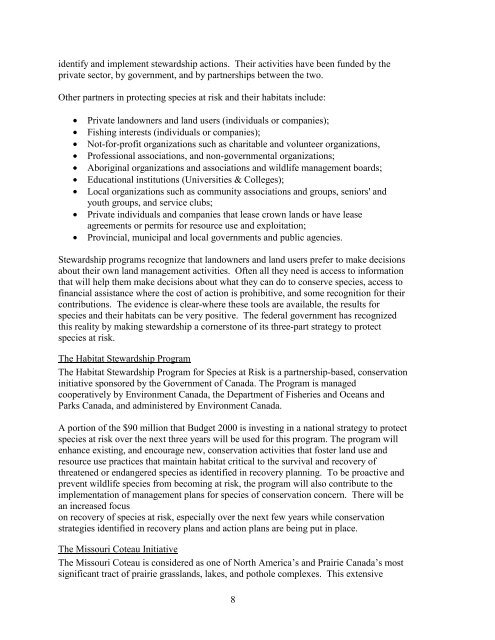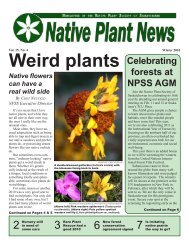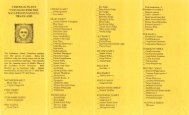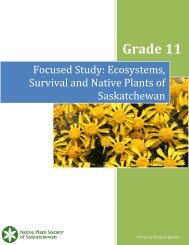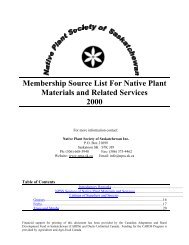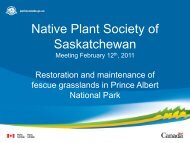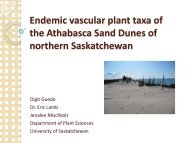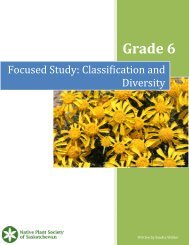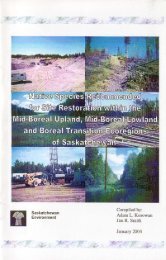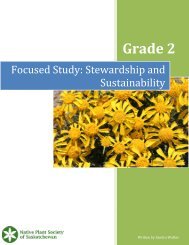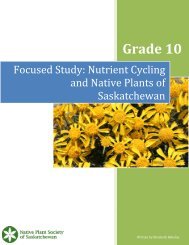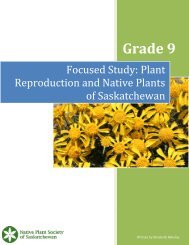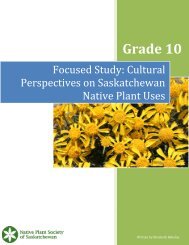Native Plants As Habitat For Wildlife - Native Plant Society of ...
Native Plants As Habitat For Wildlife - Native Plant Society of ...
Native Plants As Habitat For Wildlife - Native Plant Society of ...
You also want an ePaper? Increase the reach of your titles
YUMPU automatically turns print PDFs into web optimized ePapers that Google loves.
identify and implement stewardship actions. Their activities have been funded by the<br />
private sector, by government, and by partnerships between the two.<br />
Other partners in protecting species at risk and their habitats include:<br />
• Private landowners and land users (individuals or companies);<br />
• Fishing interests (individuals or companies);<br />
• Not-for-pr<strong>of</strong>it organizations such as charitable and volunteer organizations,<br />
• Pr<strong>of</strong>essional associations, and non-governmental organizations;<br />
• Aboriginal organizations and associations and wildlife management boards;<br />
• Educational institutions (Universities & Colleges);<br />
• Local organizations such as community associations and groups, seniors' and<br />
youth groups, and service clubs;<br />
• Private individuals and companies that lease crown lands or have lease<br />
agreements or permits for resource use and exploitation;<br />
• Provincial, municipal and local governments and public agencies.<br />
Stewardship programs recognize that landowners and land users prefer to make decisions<br />
about their own land management activities. Often all they need is access to information<br />
that will help them make decisions about what they can do to conserve species, access to<br />
financial assistance where the cost <strong>of</strong> action is prohibitive, and some recognition for their<br />
contributions. The evidence is clear-where these tools are available, the results for<br />
species and their habitats can be very positive. The federal government has recognized<br />
this reality by making stewardship a cornerstone <strong>of</strong> its three-part strategy to protect<br />
species at risk.<br />
The <strong>Habitat</strong> Stewardship Program<br />
The <strong>Habitat</strong> Stewardship Program for Species at Risk is a partnership-based, conservation<br />
initiative sponsored by the Government <strong>of</strong> Canada. The Program is managed<br />
cooperatively by Environment Canada, the Department <strong>of</strong> Fisheries and Oceans and<br />
Parks Canada, and administered by Environment Canada.<br />
A portion <strong>of</strong> the $90 million that Budget 2000 is investing in a national strategy to protect<br />
species at risk over the next three years will be used for this program. The program will<br />
enhance existing, and encourage new, conservation activities that foster land use and<br />
resource use practices that maintain habitat critical to the survival and recovery <strong>of</strong><br />
threatened or endangered species as identified in recovery planning. To be proactive and<br />
prevent wildlife species from becoming at risk, the program will also contribute to the<br />
implementation <strong>of</strong> management plans for species <strong>of</strong> conservation concern. There will be<br />
an increased focus<br />
on recovery <strong>of</strong> species at risk, especially over the next few years while conservation<br />
strategies identified in recovery plans and action plans are being put in place.<br />
The Missouri Coteau Initiative<br />
The Missouri Coteau is considered as one <strong>of</strong> North America’s and Prairie Canada’s most<br />
significant tract <strong>of</strong> prairie grasslands, lakes, and pothole complexes. This extensive<br />
8


